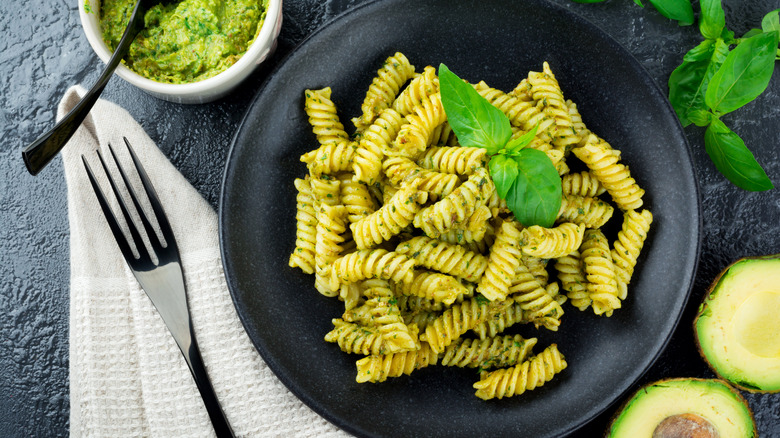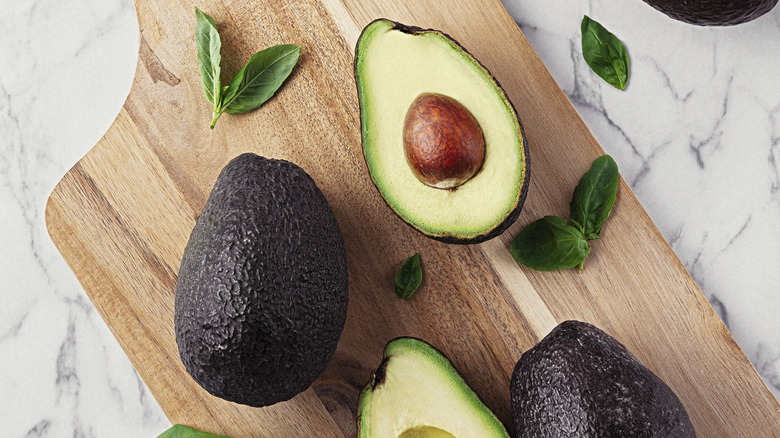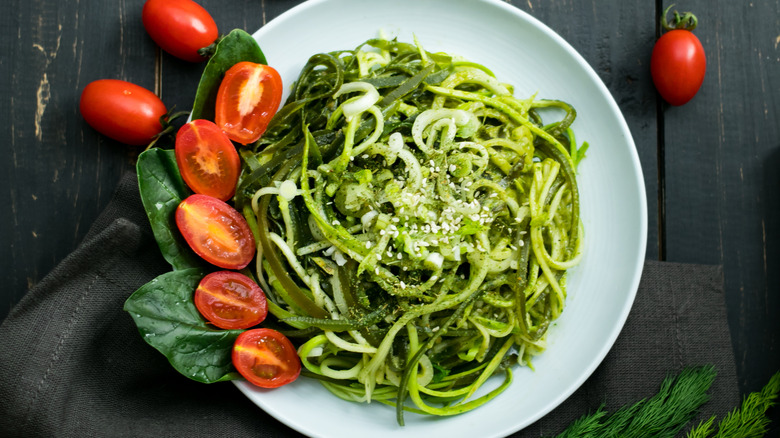Substitute Avocado For Parmesan For Creamy, Inexpensive Pesto
Pesto, in its most traditional form, is made the Ligurian way – with pounded basil, pine nuts, olive oil, garlic, salt, and cheese (typically Parmigiano Reggiano or Pecorino Romano). This is known as pesto alla Genovese, which hails from the coastal Italian city of Genoa.
But by definition, the word pesto simply means "crushed." So today, like so many other recipes that originated elsewhere and have made their way to America, we tend to take more liberties that take pesto recipes beyond basil sauce — crushing, pounding, or blending all sorts of ingredients together and calling it pesto. One of those excellent substitutes for the traditional cheese is avocado.
You may not think to throw a large piece of fruit into your pesto, but adding some avocado to the mix can go a long way. From upping the creamy factor to changing the nutritional value to lowering costs, it may be worth reaching for an avocado over parmesan cheese next time you make a fresh batch of pesto.
What substituting an avocado can do for your pesto
If you like your pesto on the creamy side, rather than more gritty or nutty in texture, then adding avocado may be the way to go. Because avocado is naturally fatty, oily, and creamy in consistency, its addition helps to emulsify the whole pesto mixture. It's a great replacement for another fat in your recipe, like parmesan cheese.
And when you use avocado instead of cheese, it not only makes the recipe dairy-free — which can be a great option for those who are vegan or lactose intolerant — but it also impacts the overall nutritional value of the pesto. With avocado, you opt for a heart-healthy fat that's rich in essential fatty acids, high in fiber, and packed with vitamins and minerals.
Lastly, while avocados aren't necessarily cheap, they are definitely a more affordable substitute in comparison to Parmigiano Reggiano or Pecorino Romano cheese. Using one ripe avocado in your recipe as opposed to half a cup to a cup of Italian cheese can make for a more cost-efficient batch of pesto that'll still taste deliciously creamy.
Tips for making avocado pesto
There are lots of ways you can incorporate avocado into your pesto — whether you're replacing the cheese in your recipe, the olive oil, or simply adding avocado to the whole mix. No matter how you go about it or which recipe you choose, there are some things to keep in mind that'll help make your avocado pesto the best it can be.
This might seem obvious, but picking a ripe avocado is crucial to the pesto's overall flavor and creaminess. If your avocado isn't quite ripe yet, the sauce could turn out a little rough or bitter, so choose a ripe or slightly overly ripe avocado that's soft to the touch. Go for a variety like Hass, which is rich, creamy, and great for sauces.
Since avocados tend to oxidize and brown very quickly, it's recommended to make the avocado pesto fresh and eat it as soon as possible. If you're storing it, you can keep the pesto in an air-tight container for up to three days in the fridge with some plastic wrap pressed up against the top or a light layer of olive oil drizzled over it. Including lemon juice in the recipe can also help preserve the pesto's vibrant green color.



